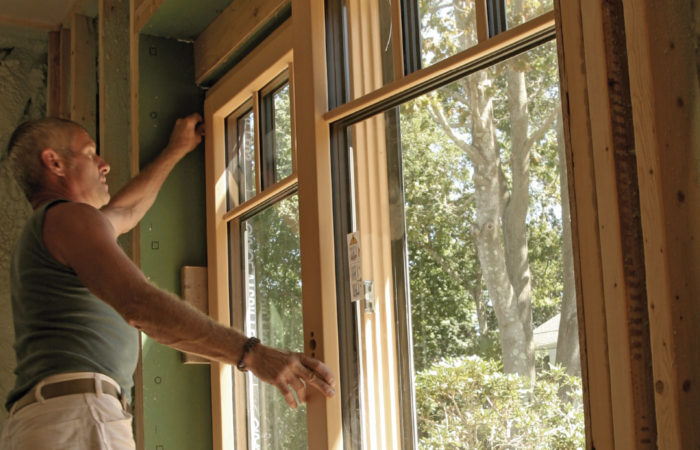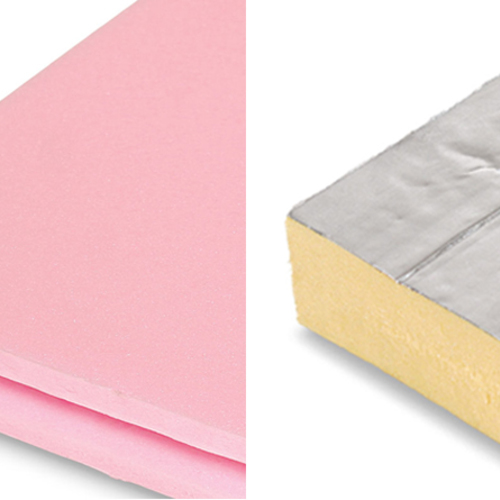
Insulation is often chosen mostly on the basis of how well it stops the flow of heat—its R-value. Insulation with a high R-value—such as spray polyurethane foam or rigid polyisocyanurate—is at least twice as effective as, say, loose-fill fiberglass. Wall or roof assemblies with higher R-values typically cost more but translate into lower heating and cooling bills.
In reality, choosing insulation is rarely as simple as comparing R-values, and relying on R-values alone can be misleading and short-sighted. To be sure, the thermal properties of insulation are important, but builders and homeowners have many variables to consider:
- How much does it cost?
- How difficult is it to install?
- How available is it?
- How safe is it?
- Is it an air or moisture barrier?
- What are the environmental consequences of choosing a particular kind of insulation?
A good place to start is the International Residential Code (IRC), which spells out the minimum amount of insulation for basements, walls, and roofs. This information is summarized in a table (R401.1.2) that breaks down minimum R-values by application (where it will be used) and location (the climate zone where the house will be built). Take, for example, wood-framed walls. In climate zone 1, which encompasses the warmest areas of the continental U.S., R-13 insulation meets code minimums for exterior walls. If you live in climate zone 6 or 7, you will need insulation between the wall studs plus a layer of continuous insulation to control thermal bridging. The code offers two possible ways of doing that: R-20 insulation in the wall cavities and a continuous layer of R-5, or R-13 in the wall cavities plus R-10 of continuous insulation.
These values are code minimums for new construction, but many builders are aiming for better performance than that. Insulation for a “Pretty Good House,”…
Weekly Newsletter
Get building science and energy efficiency advice, plus special offers, in your inbox.

This article is only available to GBA Prime Members
Sign up for a free trial and get instant access to this article as well as GBA’s complete library of premium articles and construction details.
Start Free TrialAlready a member? Log in















9 Comments
Scott, good and comprehensive overview! One comment, regarding Pretty Good House performance: the values you mention are what the group who originally developed the concept chose for our climate, zone 6. They were taken directly from what at the time was a recent publication by Building Science Corp and Building America: https://www.buildingscience.com/documents/bareports/ba-1005-building-america-high-r-value-high-performance-residential-buildings-all-climate-zones/view. They also correlate closely with the recommendations of engineer Harold Orr, the principal designer of the house that Passivhaus and Canada's R2000 program were based on: https://www.ecohome.net/guides/1418/the-principal-designer-of-the-house-that-inspired-the-global-passivhaus-movement-reflects-on-the-project-that-started-it-all/. In other climate zones, other insulation levels will be more appropriate.
Really excellent review examining currently available home insulation choices on many important dimensions. Nice illustrative photos too. Articles like this may be the most useful or most impactful for promoting good design practices.
The article is already long, but might mention to beginners that some unhealthy insulation materials have been banned or fallen out of favor, but could be encountered in renovations (e.g., asbestos and vermiculite). Perhaps reference a different article on this topic.
In addition to mentioning lingering odor from botched site-applied spray foam, might mention that some people are sickened or allergic to this lingering odor. I know someone who couldn’t live in his home after a spray foam application, and had to move out and sell for a loss. As mentioned in the article, spray foam can’t be removed easily or entirely. So this is a low probability but very serious financial and health risk to consider. Given the global warming potential, high cost, and health and safety risks of spray foam, I cringe whenever I see spray foam presented, without caveats, in various OTHER articles as a good insulation practice in “Green” Building Advisor.
I wouldn’t classify polyiso as “high” cost, versus EPS and XPS as “moderate” cost. Especially if you consider $/R-value per inch, they are comparable in cost. Polyiso is not in the same cost class as wood fiber and spray foam, nor are cotton batts cheaper than polyiso, from the suppliers I've seen.
Mineral wool has some unique advantages in fireproofing and sound attenuation. It is fireproof, even when exposed for an extended period to an open flame. So a very useful material in areas subject to wildfires. Some mineral wool batts are thinner to fit interior partitions specifically for soundproofing. Its less subject to infestation damage from insects than foam boards. It also might be more likely to be installed properly in walls compared to squishy fiberglass batts.
Robert and Michael,
Thanks for your comments. I've edited the text accordingly. Cost ranges are never exact, but it probably makes sense to lump the three rigid board products in the same "moderate" category.
Fiberglass batts are, indeed, the ultimate DIY option... but as I found out recently, it's not necessarily going to be the least expensive option. When pricing out insulating the walls in the small house I'm building, I found that it was 10% LESS expensive to hire a pro team to install wall-spray/damp-spray cellulose than for me to install fiberglass batts myself. That was a first for me, finding a pro option cheaper than the DIY option.
Great article, thanks. I'd love to see more info here on how phenolic insulation compares--Kingspan Kooltherm is a brand example.
How about sheep wool?
Thanks for the nice summary of each option in one article. I wonder if one was missed - pouring and raking insulation into ceilings. This would seem to ensure even coverage, counting bags per cubic foot of space. Is this economical and effective?
What about GPS rigid insulation, any thoughts on it yet?
Scott mentioned Neopor in his article, which is a brand name for GPS (graphite-impregnated EPS). It's a good product--higher R-value than EPS, remains stable over time, similar carbon emissions.
Log in or become a member to post a comment.
Sign up Log in